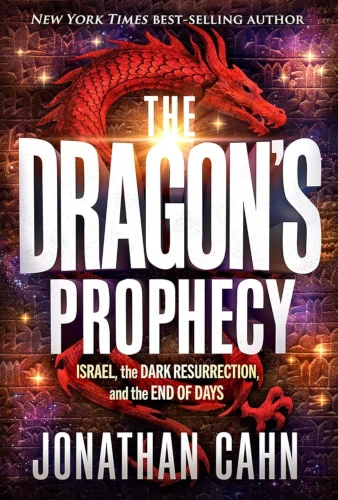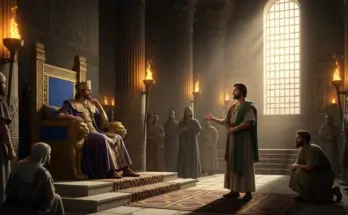Why does Daniel 7 feel so different from the stories we read earlier in the book? The chapter shifts from familiar narratives to a vision filled with strange beasts and a glorious throne room. Many beginners find this hard to understand. Yet Daniel 7 gives us one of the clearest pictures of God’s plan to bring His kingdom into the world. The images are symbolic. The message is not. The chapter shows that God rules over human history and that He gives the kingdom to His Son.

Dragon’s Prophecy by Jonathan Cahn
For the first time ever, Jonathan Cahn will open up End-Time Prophecy to reveal the mysteries behind the End of the Age and what is now happening before our eyes – even the hidden keys to victory in the light of what’s coming – and how to overcome your Dragon!
THE DRAGON’S PROPHECY – Israel, The Dark Resurrection, and the End of Days
Get Yours on AmazonWe read this vision during the reign of Belshazzar. Judah was still in exile. Empires ruled the world. God’s people felt small and powerless. They needed hope. God gave Daniel a vision that reached across centuries. The four beasts rise and fall. Their rule ends. Then the Ancient of Days judges the kingdoms. Finally, the Son of Man receives authority forever. When we read this, we see how God prepares His people for the coming of Jesus.
This chapter also helps us understand why Jesus used the title Son of Man. He did not choose that title at random. He used the title to declare His divine authority. When Jesus ascended to heaven, He fulfilled this scene. He came to the Ancient of Days. He received the kingdom. This chapter encourages us to trust Him today.
The Setting of Daniel’s Vision (Daniel 7:1–3)
Daniel received this vision during the first year of Belshazzar. Babylon was beginning its decline. Persia was rising. The world felt unstable. Daniel saw a great sea stirred by four winds. The sea often represents chaos or the troubled nations of the world. The winds hint at God’s involvement. He allows kingdoms to rise. He allows them to fall. Nothing happens outside His control.
The vision shifts from the natural world to symbolic imagery. Daniel saw four beasts rising from the sea. Each beast was different. The images felt intense. Yet these symbols point to real empires. The vision does not predict fantasy worlds. It describes the flow of actual history. Each beast grows out of the political turmoil represented by the sea.
When we teach Daniel 7, we remind beginners that apocalyptic visions use symbols to reveal truth. They do not hide truth. They show how God works behind the scenes. Daniel needed comfort. God gave him a vision that revealed His rule over every nation.
The First Beast: Babylon as the Winged Lion (Daniel 7:4)
The first beast looked like a lion with eagle’s wings. This image fits Babylon. Babylon used lions in its art and royal symbols. The wings show strength and speed. Yet Daniel saw the wings plucked off. The beast stood like a man. It received a human heart.
This matches the story of Nebuchadnezzar. He became proud. God humbled him. He lost his reason. Later he lifted his eyes to heaven. God restored him. His heart changed. Babylon looked strong, but it was still under God’s rule.
We use this moment in Daniel 7 to help beginners understand God’s sovereignty. Empires reach great heights. They fall when God decides their time is done. Babylon seemed unstoppable, yet God removed its wings. He reminded the king that heaven rules.
The Second Beast: Medo-Persia as the Bear (Daniel 7:5)
The second beast looked like a bear raised up on one side. It held three ribs in its mouth. The picture seems uneven. This fits the Medo-Persian empire. Persia became stronger than Media. The partnership was real but unequal. The bear’s raised side reflects this imbalance.
The three ribs picture regions that Persia consumed. Many see these as Babylon, Lydia, and Egypt. These areas marked major Persian victories. The bear rose to rule a vast territory. Yet the bear followed the lion. Its time was appointed by God.
When beginners read Daniel 7, we show them how God directs history with purpose. The bear did not rise because it was lucky. God allowed it to rise. Persia played a role in returning the Jewish people to their land. God used an empire to bless His people.
The Third Beast: Greece as the Winged Leopard (Daniel 7:6)
The third beast looked like a leopard with four wings and four heads. This image fits the Greek empire under Alexander the Great. A leopard moves quickly. Wings show even greater speed. Alexander conquered the ancient world with astonishing speed. His campaigns changed history.
After Alexander’s Death
Alexander died young. His empire did not stay united. Four major generals took control. The four heads match this division. Each leader held authority over a part of the empire. These divisions shaped the world around Judea and prepared the way for later events in Scripture.
Why This Matters
The mention of Greece in Daniel 7 reminds us that God guides even rapid changes in world power. Empires rise quickly. They fall quickly. Yet God uses these movements to prepare for His kingdom. Greek culture and language spread across the world. This helped the gospel spread centuries later. God used history to prepare the way for Jesus.
The Fourth Beast: Rome as the Terrifying Iron Monster (Daniel 7:7–8)
The fourth beast looked different from the others. It felt terrifying. Daniel could not compare it to any animal. It had iron teeth. It crushed everything. It had ten horns. This picture fits Rome. Rome ruled with strength that matched iron. Rome swallowed nations. Rome built systems that shaped the ancient world.
The Little Horn
Daniel saw a little horn rise among the ten. This horn had eyes like a man. It spoke proud words. Many early Christian readers identified this figure with rulers who opposed God’s people. Partial preterist interpretation sees this horn as connected to the first-century conflict between Rome and the people of God. Rome held great power. Its rulers often acted with pride. The horn’s rise shows a specific figure who challenged God’s authority.
The Nature of the Fourth Beast
Rome’s strength felt overwhelming. Yet Rome followed Babylon, Persia, and Greece. The beast did not stand outside God’s plan. God allowed Rome to rise because Rome served His purpose. Rome created roads. Rome kept order. Rome built the world that received Jesus.
When we teach Daniel 7, we help beginners see how the fourth beast prepares for the next part of the vision. Human kingdoms rise in power. Their rule ends. God’s kingdom begins.

Bamboozled Believers by Michael Biehler
Michael Biehler pilots an intellectual adventure while challenging every reader to reexamine his core beliefs. This game-changing, subversive Christian crossover book will at first confound and then delight all who love the truth. Bamboozled Believers makes sense and it will help you to make to make sense of the Bible too.
To preview the book, go to http://bamboozledbelievers.com
Get Yours on AmazonThe Ancient of Days Takes His Seat (Daniel 7:9–12)
This section gives us one of the most powerful images in Scripture. Thrones are set. The Ancient of Days sits to judge. His clothing is white. His throne burns with fire. A river of fire flows before Him. Countless servants stand near Him. The court sits. Books open.
God Judges the Kingdoms
The beasts act with violence. The Ancient of Days responds with judgment. The fourth beast is slain. Its body is burned. The other beasts lose their authority. They receive more time. Their kingdoms decline. God shows that His judgment reaches every empire.
Symbolic Imagery
We teach beginners that this scene is symbolic. God does not sit on a literal fiery chair. The images show His purity and authority. Fire pictures judgment. Books show accountability. The court shows order. Nothing escapes God’s care. He rules with wisdom.
Why This Matters
Daniel saw a world filled with fear. Yet he also saw God in control. The Ancient of Days does not hide. He sits in judgment. He prepares to give the kingdom to His Son.
The Son of Man Receives the Kingdom (Daniel 7:13–14)
This section stands at the heart of Daniel 7. Daniel saw one like a Son of Man coming with the clouds of heaven. He came to the Ancient of Days. He received authority, glory, and a kingdom. All nations serve Him. His kingdom never ends.
Coming with the Clouds
Many beginners think this refers to the second coming. Yet the text says the Son of Man comes to the Ancient of Days. He goes upward, not downward. This matches the ascension of Jesus. After His resurrection, He rose to heaven. He came to the Father. He received the kingdom. Early Christians understood this scene as Jesus’ enthronement.
Jesus Uses the Title
Jesus called Himself the Son of Man. This title comes from Daniel 7. When He stood before the high priest, He said the Son of Man would come with the clouds and sit at the right hand of God. They knew what He meant. He claimed authority promised in Daniel’s vision.
The Kingdom Begins
When Jesus ascended, He received the kingdom. He poured out the Spirit. He began His reign. The gospel spread across the world. Rome could not stop it. The beasts lost their power. The Son of Man rules. His kingdom continues through His people.
The Vision Explained to Daniel (Daniel 7:15–28)
Daniel felt troubled. The visions felt overwhelming. An angel explained the meaning. The four beasts represent four kingdoms. They rise. They fall. The saints receive the kingdom forever.
The Saints Receive the Kingdom
This part encourages beginners. The Son of Man receives the kingdom. He shares it with His people. The kingdom does not belong to earthly rulers. It belongs to the holy ones. They rule because they belong to Jesus.
The Fourth Beast’s Opposition
The little horn makes war against the saints. He prevails for a time. Yet God judges him. The court sits. The horn loses power. The kingdom goes to the saints. Partial preterist interpretation sees this fulfilled in the first century. Persecution grew under Rome. God judged that generation. Jesus received the kingdom. The church carried His authority into the world.
Daniel’s Response
Daniel kept the matter in his heart. The vision shaped his future. It shapes ours as well. We look to the Son of Man. We trust His kingdom. We remember that earthly power does not last. God rules over all.
Closing Thoughts on Daniel 7
When we finish reading Daniel 7, we see a clear message. Human kingdoms rise and fall. God’s kingdom lasts forever. The beasts look frightening. They argue. They boast. Yet God sits on His throne. His court decides their future. The Ancient of Days rules with wisdom and justice. The Son of Man receives the kingdom.
This vision points us to Jesus. He came in humility. He rose in glory. He ascended to the Father. He received authority over all nations. He pours out His Spirit. He leads His people. His kingdom grows through the gospel. He does not need armies. He does not rely on force. He rules by truth. He reigns through grace.
This chapter also teaches us to trust God when the world feels chaotic. The sea roars. Empires rise. Leaders boast. Yet God remains in control. The beasts cannot overthrow His plan. Their time passes. God’s kingdom continues. This vision invites beginners to see the world through God’s eyes. We learn that Jesus reigns today. His kingdom advances. Nothing can stop it.



